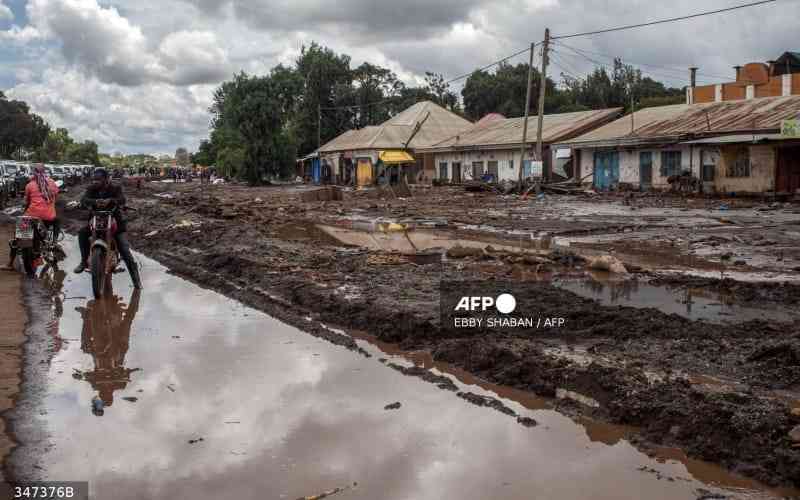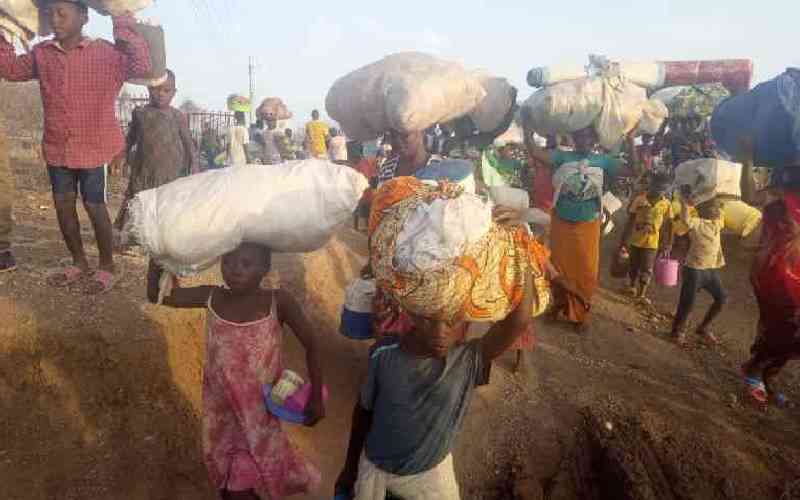By Dann Okoth
More than 300 million people in Sub-Saharan Africa are at risk of starvation by 2050 if food production in the continent is not stepped up considerably, it has emerged.
But the potential disaster, which could also see up to 52 million children in the region severely malnourished can be averted if the right policies are pursued, experts attending a regional workshop on agriculture in Nairobi offered.
These, they say, would include the necessary investments prioritisation and countries collaborating to share knowledge with each other to improve agricultural output – with the view to achieving food security the workshop organised by Global Development Network (GDN) heard. “Taking specific decisions now to manage future challenges and make the most of emerging opportunities has become imperative,” remarked Prof Chris Ackello Ogutu of the University of Nairobi as he presented a paper: “Long-term challenges to food security and rural livelihoods in Sub-Saharan Africa at the workshop.”
The GDN Global Research Project, “Supporting Policy Research to Inform Agricultural Policy in Sub-Saharan Africa and South Asia”, supported by the Bill and Melinda Gates Foundation, aims to help shape North-South and South-South debates on agricultural policies. Designed as a policy research project, it seeks to enrich the body of knowledge related to agricultural issues.
In doing so, it draws from the existing knowledge base, especially cross-country research findings, in a scientifically rigorous manner yet one that is both timely and easily accessible to policymakers and the informed public.
“There is need to spur innovation in response to climate change, population growth and new market opportunities, with increased investment in agricultural research and development, multiplication of new crop and livestock genetics and dissemination of techniques to use soil, water, labour and land more effectively and sustainably,” Mr Ogutu added.
Meanwhile, an earlier assessment by Consultative Group on International Agricultural Research found that between now and 2050; the demand for maize in the developing countries will double, and by then maize will have become the crop with the greatest production globally and in the developing world.
More than 300 million Africans are dependent on maize. Moreover, nearly all maize in Africa is grown under rain-fed conditions, and frequent droughts now put a majority of small-scale farmers in the continent at risk of starvation.
Climate change studies predict considerable warming of sub-Saharan Africa by 2050. And when temperatures rise by even one single degree Celsius, yields reduce by 65 per cent. Global temperatures are expected to rise by two degrees centigrade by 2050. This will have adverse effects on agricultural production; food prices, health and wellbeing with yields of rice, wheat and maize for example, are expected to decline by about 15 per cent, 35 per cent and nine per cent respectively. With crop yields succumbing to water and heat stress, food prices take on an extra significance.
Global temperature
Volatile prices will impose huge financial burdens on economies of Sub-Saharan Africa, condemning poor farmers to a constant state of underdevelopment. Ogutu says: “Without alternative livelihood strategies, price volatility leads to income volatility, inadequate access to credit, a shift towards low-risk production technologies and an inability to respond opportunistically.”
He noted climate change has caused cereal consumption to decrease since the year 2000, from 117kg per year. The forecast is 89kg per year in 2050. He added that this would lead to declining calorie availability, predicting that by 2050 there will be 52 million malnourished children in Sub-Saharan Africa.
But adapting to climate change will be costly, the don warned. The predicted cost in Sub-Saharan Africa as a percentage of the Gross Domestic Product (GDP) is extremely large in comparison to any other global region, mainly because GDP levels are comparatively low. Agriculture sector adaptation costs in the region account for 40 per cent of the total, principally linked to construction of more rural roads. If agricultural productivity could be increased, the region would be less vulnerable and better equipped to meet future climate change challenges.
“However there is need to adopt policies that raise agricultural productivity to meet Sub-Saharan Africa’s own food needs, develop specialist niche products and become a competitive player in the global market, besides strengthening safety nets. Improving health and education, building assets to support livelihoods for small-scale producers to participate equally in national and global markets is also key,” he says.
Stay informed. Subscribe to our newsletter
Fertiliser use
Prof Saa Dittoh of the University for Development Studies in Ghana challenged Sub-Saharan African Governments to adopt policies that promote fertiliser use in the region in order to improve agricultural outputs and avert the looming hunger.
“Fertiliser use in Sub-Saharan Africa is low because of poor inherent soil fertility, poor extension services, constraints to fertiliser availability and limited availability of complimentary inputs,” he says.
He adds: the profitability of fertiliser use in the region is lower than elsewhere in the developing world, reflecting low crop response to fertiliser, the region’s poorly developed marketing systems, its difficult production environment and the unstable prices of outputs.”
He observed policy formulation in the region has not always been based on critical agronomic analyses of the advantages and disadvantages as well as opportunities and challenges facing Sub-Saharan Africa farmers. “Agricultural policy makers in the region must move away from the one-size-fits-all philosophy and each country must implement policies that consider the diversity of its agricultural production system,” he says. But for agricultural productivity to improve in the region, policies that guide irrigation and water use efficiency in Sub-Saharan Africa noted the GDN’s Briefing Paper Number four at the workshop.
It observed Sub-Saharan Africa has vast untapped water resources, adding that expansion of irrigation area has the potential to make substantial contribution to agricultural development and address the problem of food insecurity.
“Many irrigation schemes in the past failed due to a combination of factors, including high investment costs, poor planning and a lack of maintenance. It is recommended that new irrigation schemes are initiated in response to demand from farmers, increasing the chances of local management and maintenance schemes. “Irrigation cannot be treated in isolation and must be considered alongside other elements of agricultural development including improved markets, institutional and legal transparency, clarity of land rights, efficient use of inputs, extension services for farmers, research and development and environmental management.”
But while the GDN initiative aims at bringing policy researchers and policy makers together to create policy frameworks that would spur agricultural development, the researchers have been challenged to engage more with Governments.
Lillian Mbogo-Omollo, Chief Executive Officer of The New Partnership for Africa’s Development (Nepad) Secretariat in Kenya expressed her frustration at the lack of engagement between researchers and Government.
Policy makers
“The dearth in the engagement of researchers and policy makers is worrying. Often, the researchers to not show up at the meetings or roundtables to discuss the development frameworks; it is important that the researchers are brought on board,” she says. Nepad has produced a framework for change called the Comprehensive African Agriculture Productivity Development Programme that is a blueprint for investment in the agriculture sector – it aims to increase the investment in agriculture in each country to 10 per cent of the budget – only realised by just over one third of African countries currently.
“Such initiatives need the input of researchers and policy analysts in order to come up with an agricultural roadmap that suits the needs of the continent,” Omollo says. But according to Diamond Lalji, chairman of the Cereal Millers Association, Africa leads in the production of research papers. He also opines that there has been a lack of political goodwill to implement some of the research findings. “In Kenya for instance we produce some of the best research papers but implementation of the ideas are almost nil – instead other countries borrow our ideas and implement them for their own benefit,” he says.
 The Standard Group Plc is a
multi-media organization with investments in media platforms spanning newspaper
print operations, television, radio broadcasting, digital and online services. The
Standard Group is recognized as a leading multi-media house in Kenya with a key
influence in matters of national and international interest.
The Standard Group Plc is a
multi-media organization with investments in media platforms spanning newspaper
print operations, television, radio broadcasting, digital and online services. The
Standard Group is recognized as a leading multi-media house in Kenya with a key
influence in matters of national and international interest.
 The Standard Group Plc is a
multi-media organization with investments in media platforms spanning newspaper
print operations, television, radio broadcasting, digital and online services. The
Standard Group is recognized as a leading multi-media house in Kenya with a key
influence in matters of national and international interest.
The Standard Group Plc is a
multi-media organization with investments in media platforms spanning newspaper
print operations, television, radio broadcasting, digital and online services. The
Standard Group is recognized as a leading multi-media house in Kenya with a key
influence in matters of national and international interest.








